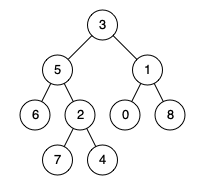1650. Lowest Common Ancestor of a Binary Tree III
1650. Lowest Common Ancestor of a Binary Tree III
Description
Difficulty: Medium
Related Topics: Hash Table, Tree, Binary Tree
Given two nodes of a binary tree p and q, return their lowest common ancestor (LCA).
Each node will have a reference to its parent node. The definition for Node is below:
1 | class Node { |
According to the definition of LCA on Wikipedia: “The lowest common ancestor of two nodes p and q in a tree T is the lowest node that has both p and q as descendants (where we allow a node to be a descendant of itself).”
Example 1:

1 | Input: root = [3,5,1,6,2,0,8,null,null,7,4], p = 5, q = 1 |
Example 2:

1 | Input: root = [3,5,1,6,2,0,8,null,null,7,4], p = 5, q = 4 |
Example 3:
1 | Input: root = [1,2], p = 1, q = 2 |
Constraints:
- The number of nodes in the tree is in the range [2, 105].
- -109 <= Node.val <= 109
- All
Node.valare unique. p != qpandqexist in the tree.
Hints/Notes
- 2023/08/30
- It’s actually find the intersection of 2 lists
- No solution from leetcode
Solution
Language: C++
1 | /* |